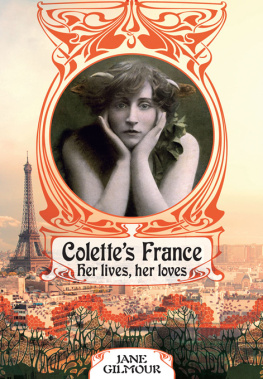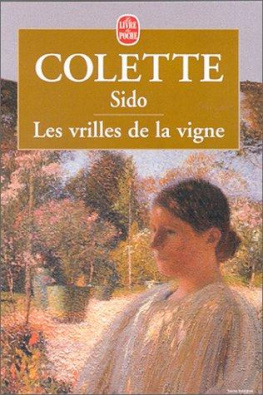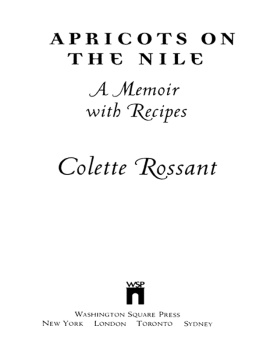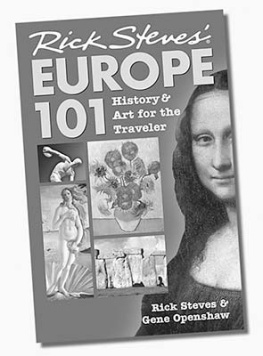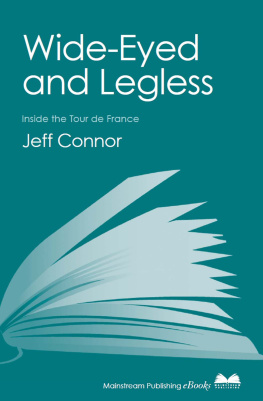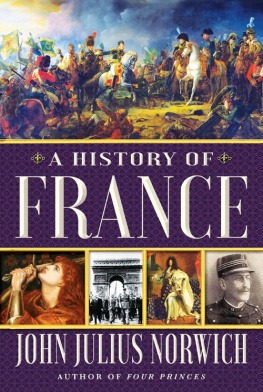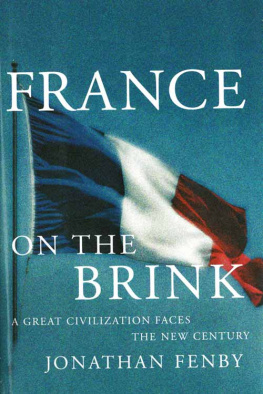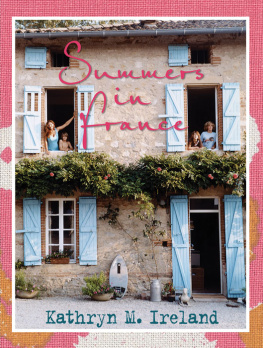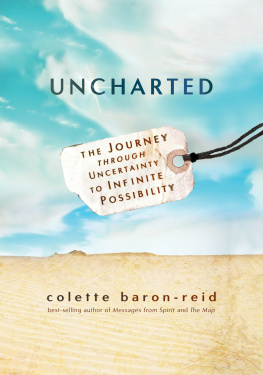Colette - Colettes France: her lives, her loves
Here you can read online Colette - Colettes France: her lives, her loves full text of the book (entire story) in english for free. Download pdf and epub, get meaning, cover and reviews about this ebook. City: Richmond;Vic, year: 2013, publisher: Hardie Grant Books, genre: Non-fiction. Description of the work, (preface) as well as reviews are available. Best literature library LitArk.com created for fans of good reading and offers a wide selection of genres:
Romance novel
Science fiction
Adventure
Detective
Science
History
Home and family
Prose
Art
Politics
Computer
Non-fiction
Religion
Business
Children
Humor
Choose a favorite category and find really read worthwhile books. Enjoy immersion in the world of imagination, feel the emotions of the characters or learn something new for yourself, make an fascinating discovery.
- Book:Colettes France: her lives, her loves
- Author:
- Publisher:Hardie Grant Books
- Genre:
- Year:2013
- City:Richmond;Vic
- Rating:3 / 5
- Favourites:Add to favourites
- Your mark:
- 60
- 1
- 2
- 3
- 4
- 5
Colettes France: her lives, her loves: summary, description and annotation
We offer to read an annotation, description, summary or preface (depends on what the author of the book "Colettes France: her lives, her loves" wrote himself). If you haven't found the necessary information about the book — write in the comments, we will try to find it.
Colettes France: her lives, her loves — read online for free the complete book (whole text) full work
Below is the text of the book, divided by pages. System saving the place of the last page read, allows you to conveniently read the book "Colettes France: her lives, her loves" online for free, without having to search again every time where you left off. Put a bookmark, and you can go to the page where you finished reading at any time.
Font size:
Interval:
Bookmark:

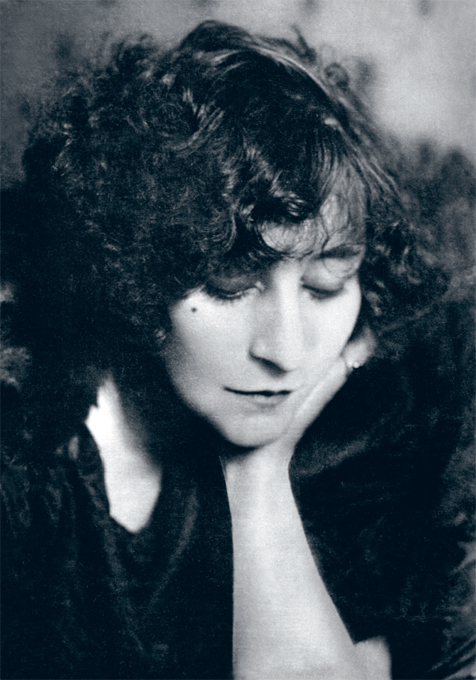

Published in 2013 by Hardie Grant Books
Hardie Grant Books (Australia)
Ground Floor, Building 1
658 Church Street
Richmond, Victoria 3121
www.hardiegrant.com.au
Hardie Grant Books (UK)
Dudley House, North Suite
3435 Southampton Street
London WC2E 7HF
www.hardiegrant.co.uk
All rights reserved. No part of this publication may be reproduced, stored in a retrieval system or transmitted in any form by any means, electronic, mechanical, photocopying, recording or otherwise, without the prior written permission of the publishers and copyright holders.
The moral rights of the author have been asserted.
Copyright text Jane Gilmour
Design Hardie Grant Books 2013
A Cataloguing-in-Publication entry is available from the catalogue of the National Library of Australia at www.nla.gov.au
Colettes France: Her lives, her loves
eISBN 978 1 74358 067 7
Publishing Director: Fran Berry
Project Editor: Helen Withycombe
Editor: Janet Austin
Digital Editor: Hannah Koelmeyer
Design Manager: Heather Menzies
Cover and internal print design: Clare OLoughlin
Cover image: Lipnitzki/Roger-Viollet
Contents
Epilogue Closing the circle
My first encounter with the world of Colette and her writing was when I was still at school. I was studying French, and extracts from her work were occasionally chosen as texts for dictation. I remember particularly an extract from Claudine lcole (Claudine at School) about the woods that surrounded the little village of Montigny. When I reread that passage even now, so many years later, I am transported back to my schoolroom, just as Colette was transported back to the schooldays of her youth through the story of Claudine.
Colettes imagery and the rhythm of her prose entranced me even then, as I struggled with the complex structure of her sentences and the challenges of her vocabulary. Her words conjured up sounds and smells, colours and tastes. The France she described held out the promise for me, in faraway Australia, of a landscape that changed with the seasons, of a way of life deeply rooted in tradition, a culture that was embedded in the land. It seemed to me that Colette embodied a certain idea of Francean idea that was romantic, perhaps, but one that I wanted to know better. As I read more of Colettes workThe Ripening Seed, Chri, The CatI willingly entered into the obsessive and closed emotional worlds she created, where her characters were captive to an ideal of love. Colette has been accused of writing only about love. For me, her books were not so much about love as about its impossibility, about the irredeemable distance between the idea of love and its reality. More powerfully, they spoke to me of the struggle to be a woman, of what one critic had called the loneliness of a woman face to face with her destiny. It seemed to me that behind all of Colettes work stood the image of a woman who refused to forgo her own freedom. Her work spoke of a life fully lived, of a sensual curiosity and energy, and a profound feminine sensibility. When reading Colette, I had the feeling of not being alone. She was like a confidante, a friend who could see into the human heart, who could peel back the layers of illusion and delusion that mask the complex and troublesome nature of human relationships.
After leaving school, I continued my French studies at university, where my reading of French literature ranged from the troubadour poets of the fifteenth and sixteenth centuries to the great works of the nineteenth and twentiethBalzac and Proust, Gide and Sartre. But I was constantly drawn back to Colette. Then, with my undergraduate years behind me, and the financial support of a scholarship, I decided to head straight to Paris, where I enrolled at the Sorbonne as a doctoral student. I wasnt sure what the focus of my study would be, but I knew it would have something to do with Colette.
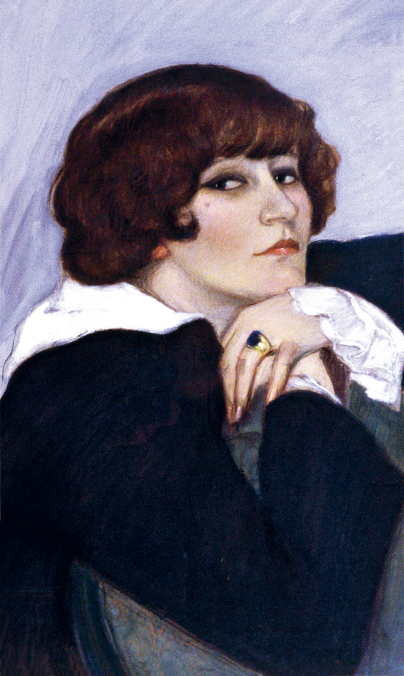
So there I was, a 22-year-old stepping out of the train at the Gare du Nord and into the city of my dreams. I can still clearly remember the taxi ride from the train station on my first day in Parispast Notre Dame, across the Seine to the Latin Quarter, up the boulevard Saint-Michel. As we drove past Notre Dame, me, I was disappointed to see that most of the faade was covered in scaffolding and sheeting. The cathedral was being steam-cleaneda process that was slowly transforming all of the city, cleaning off the centuries-old layers of soot and dirt to reveal the honeycoloured stone beneath. More distressing was the fact that I could hardly understand a word of what the taxi driver was saying to me. How could this be, after all the years I had spent learning French? It would take a couple of weeks before I became accustomed to the accent and language of working-class Parisians, the people I interacted with on the street, in the shops and cafes, on the mtro.
Life as a student in Paris was full of surprisesthe lack of structure, the process of finding a supervisor for my thesis, the challenge of obtaining a residency card (did I really need to have a document that gave my mothers maiden name?), thee ritual of organising a readers card for the Bibliothque nationale de France.
It was late 1968, and in Paris political dissent and structuralism were changing the intellectual landscape. The student riots of May 68 were only a few months back, and the Sorbonne was still in a somewhat chaotic state. Tensions between the forces of order and the student population remained very evident in the Latin Quarter. Grey windowless buses in which the armed security forces whiled away the hours and days were a threatening presence on the streets. Skirmishes between these forces and protesting student groups broke out from time to time. One afternoon I beat a hasty retreat into a cafe when I saw a group of students running down the street being pursued by a squad of truncheon-wielding security forces men. Even eighteen months later, a happy fourteenth of July celebration could turn into a nasty confrontation between members of the special security forces and innocent revellers. The Latin Quarter and Saint-Germain were still at the centre of Pariss vibrant literary and artistic life, with Jean-Paul Sartre and Simone de Beauvoir actively involved in the ongoing political situation. However, my world of study revolved around the work of a woman who was aligned with neither the existentialists nor the structuralists, and had not yet been claimed by the feminists. Her work, nonetheless, was held high in the pantheon of French writers.
I had decided that the focus of my work would be on Colettes literary style, in particular the way she used imagery. I was interested in the power of metaphor and symbol in literature, and was fascinated by her use of colour and the way she used images to create a concrete representation of an idea, feeling or state of mind. For me, Colette succeeded in making the abstract become real, using the physical world of the senses to reveal the inner world of the mind. Between the real and the imagined, she wrote, there is always the place taken by the word, magnificent and larger than the object.
Next pageFont size:
Interval:
Bookmark:
Similar books «Colettes France: her lives, her loves»
Look at similar books to Colettes France: her lives, her loves. We have selected literature similar in name and meaning in the hope of providing readers with more options to find new, interesting, not yet read works.
Discussion, reviews of the book Colettes France: her lives, her loves and just readers' own opinions. Leave your comments, write what you think about the work, its meaning or the main characters. Specify what exactly you liked and what you didn't like, and why you think so.

